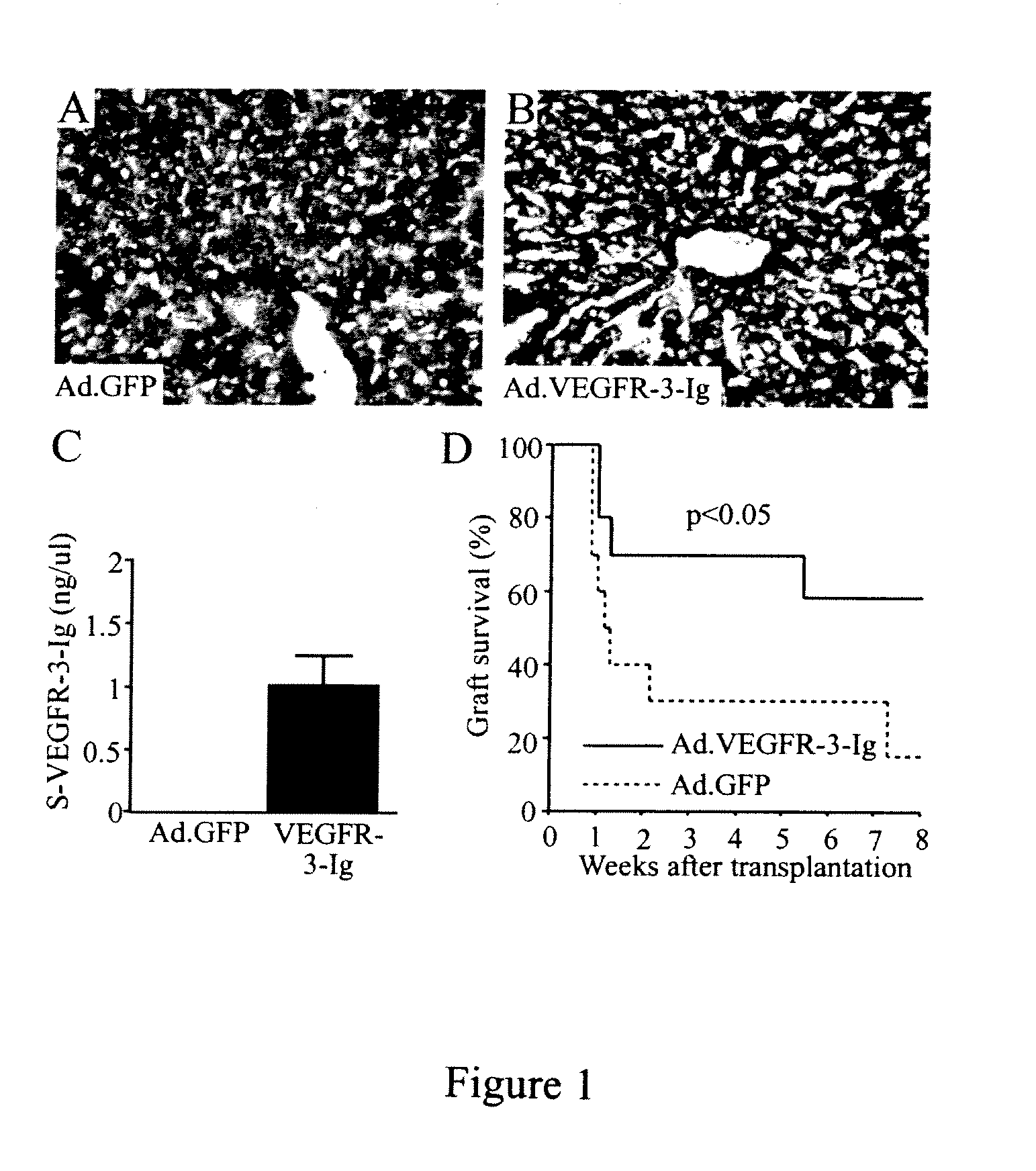Growth factor antagonists for organ transplant alloimmunity and arteriosclerosis
- Summary
- Abstract
- Description
- Claims
- Application Information
AI Technical Summary
Benefits of technology
Problems solved by technology
Method used
Image
Examples
example 1
VEGFR-2 and VEGFR-3 Fragments that Bind VEGF-A or VEGF-C
[0371]To determine the portion of a receptor's extracellular domain (ECD) that was sufficient for ligand binding, fragments of the ECDs of VEGFR-2 (R-2) and VEGFR-3 (R-3) were used to make various soluble constructs. The constructs included Fc domain human IgG fragments fused to the C-terminus of the receptor fragments. As indicated in Tables 3 and 4, some constructs were made using a heterologous (N-terminal) signal peptide derived from CD33.
[0372]Construction of Fragments and Plasmids
[0373]R-2 Constructs
[0374]To construct the VEGFR-2 / IgG expression plasmid, the construct, R-2 A, comprising the first three Ig-domains (D1-3) of VEGFR-2 was amplified by PCR using primers 5′-GCGGATCCTTGCCTAGTGTTTCTCTTGATC-3′ (SEQ ID NO: 72), and 5′-CCAGTCACCTGCTCCGGATCTTCATGGACCCTGACAAATG-3′ (SEQ ID NO: 73), and cloned into the Signal plgplus vector (Novagen, Madison, Wis.). The resulting plasmid was digested with BamHI and KpnI, treated with T4 ...
example 2
Ligand Binding Assays Involving Binding Constructs with More than One Binding Element
[0389]The assays as performed in Example 1 are repeated, substituting a binding construct with multiple binding units. For example, one employs a binding construct comprising a binding unit that binds VEGF-A and a binding unit that binds VEGF-C. One looks for the ability of such a binding construct to bind both VEGF-A and VEGF-C. This information may be obtained by using different radio- or other labels, e.g., fluorescent labels for fluorescence resonance energy transfer (FRET), on each type of ligand or use of labels on the binding construct and or ligands, to determine whether a given binding construct molecules are binding a molecule of VEGF-A and VEGF-C. Constructs that are shown to bind more than one growth factor ligand, as well as those described in Example 1 and elsewhere herein, have an indication for anti-neoplastic therapies where multiple growth factors contribute to neoplastic cell grow...
example 3
Chimeric VEGFR Binding Constructs which Bind Multiple Ligands
[0390]As stated above, constructs that bind more than one growth factor ligand have an indication as anti-neoplastic therapies where multiple growth factors contribute to neoplastic cell growth. In order to determine the efficacy of a binding construct designed to bind more than one growth factor, two chimeric binding constructs were generated and their ability of each to bind to two growth factors was measured.
[0391]The binding constructs were designed as immunoblobulin fusion proteins as described above. To construct chimeric VEGF receptor / hIgG1Fc fusion proteins, the pIgPlus vector was used to build a construct comprising the first immunoglobulin-like domain of VEGFR-3 and the second and third Ig-like domains of VEGFR-2. The construct is designated R-3D1-R2D2+3 / hIgG1Fc. To clone the R-3D1-R2D2+3 / hIgG1Fc construct, PCR was performed with CMV forward primer (18782, 5′ TACTTGGCAGTACATCTACGTATTAGTCATCGC-3′) (SEQ ID NO: 122)...
PUM
| Property | Measurement | Unit |
|---|---|---|
| Fraction | aaaaa | aaaaa |
| Time | aaaaa | aaaaa |
| Time | aaaaa | aaaaa |
Abstract
Description
Claims
Application Information
 Login to View More
Login to View More - R&D
- Intellectual Property
- Life Sciences
- Materials
- Tech Scout
- Unparalleled Data Quality
- Higher Quality Content
- 60% Fewer Hallucinations
Browse by: Latest US Patents, China's latest patents, Technical Efficacy Thesaurus, Application Domain, Technology Topic, Popular Technical Reports.
© 2025 PatSnap. All rights reserved.Legal|Privacy policy|Modern Slavery Act Transparency Statement|Sitemap|About US| Contact US: help@patsnap.com



